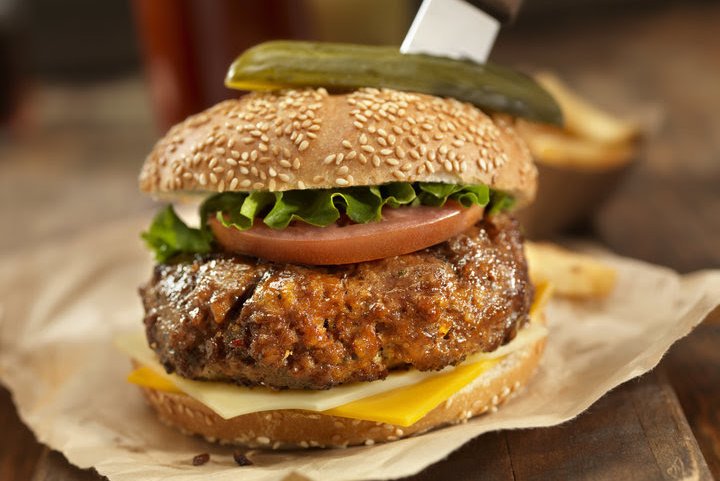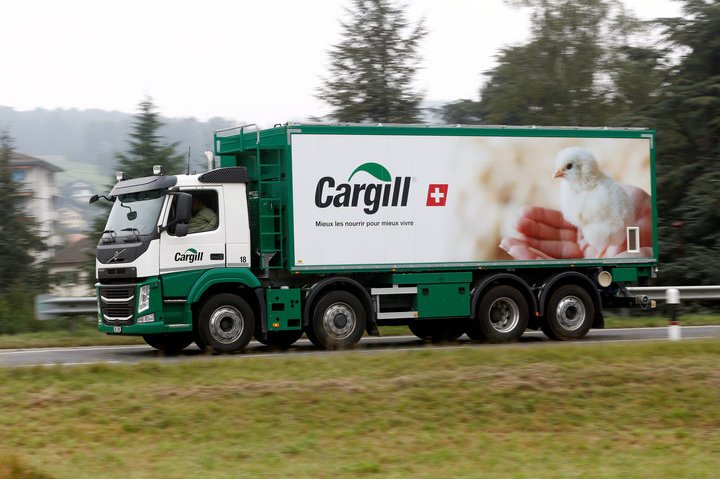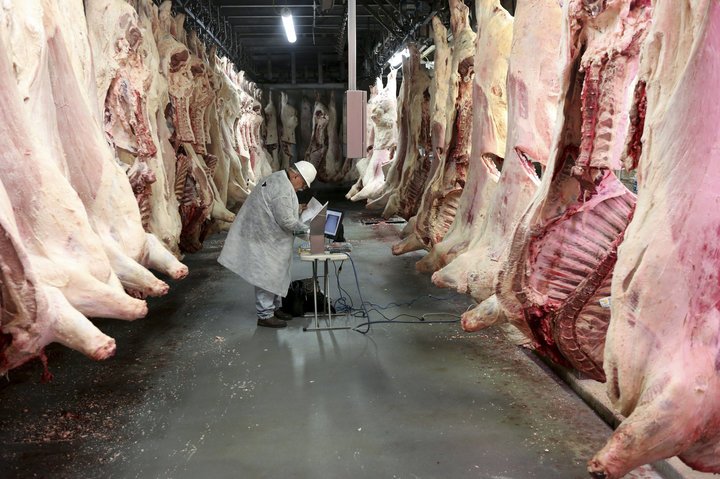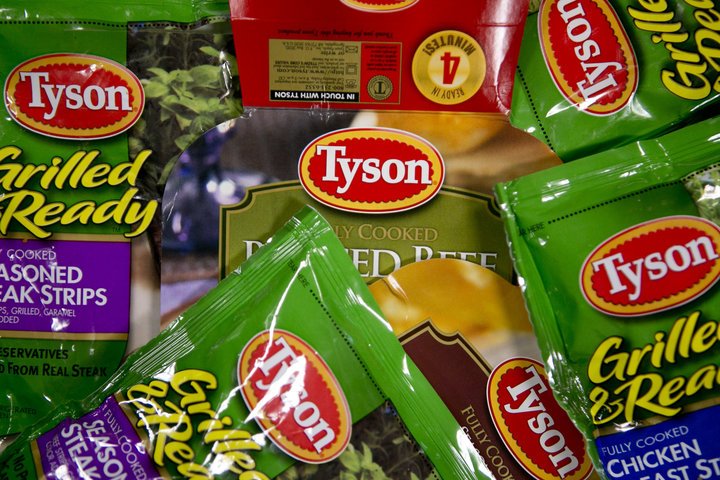|

The Giant Corporations Behind Your Burgers And Milk Have A Terrifying Climate Secret
Together, five companies have a climate footprint bigger than Exxon, Shell or BP, but we don’t talk about it.
Beef burgers, ham sandwiches, cheese slices, yogurt, bread. A good amount of the food you might eat on a daily basis is likely to have come from just three U.S companies: Tyson, Cargill and Dairy Farmers of America.
Minnesota-based Cargill is the world’s biggest food trader, selling everything from grains and beef to eggs and palm oil. Meat giant Tyson processes 35 million chickens, 424,000 pigs and 130,000 cattle every week in the U.S. And Dairy Farmers of America accounts for 30 percent of all the milk produced in the country.
And in addition to providing your breakfast, lunch and dinner, they are some of the world’s most-polluting companies.
The climate footprint of oil and gas giants such as Exxon Mobil, Shell and BP are well-known, but food companies have faced far less scrutiny. The world’s five largest meat and dairy companies combined, including Tyson, Cargill and Dairy Farmers of America, are responsible for more greenhouse gas emissions every year than any of the world’s biggest oil and gas companies.

Cargill, the food behemoth, is the U.S.'s largest privately held company.
DENIS BALIBOUSE / REUTERS
And in a week when international climate scientists have warned that the world is rapidly running out of time to reduce emissions and keep global warming to within 1.5 degrees Celsius, this matters more than ever.
So where does this mega climate footprint come from? The emissions cover everything from the production of crops to feed chickens, pigs and cows to the methane emissions released by burping cattle. Some less obvious emissions include those associated with farm machinery fuel and the production of chemicals and other inputs needed to grow grain, palm oil and other food crops.
The food sector as a whole is estimated to be responsible for as much as 29 percent of global man-made greenhouse gas emissions. But meat and dairy account for the vast majority of those emissions. A major study published this week says U.K. and U.S. citizens need to cut consumption of beef by 90 percent and consumption of milk by 60 percent to keep global warming at or below 2 degrees Celsius.
 Sides of beef hang at the Cargill beef processing plant in Schuyler, Nebraska.
LANE HICKENBOTTOM / REUTERS
Sides of beef hang at the Cargill beef processing plant in Schuyler, Nebraska.
LANE HICKENBOTTOM / REUTERS
Cargill and Tyson have set themselves targets for reducing emissions, and Dairy Farmers of America told HuffPost that it plans to set emission-reduction targets by the middle of 2019. But environmental campaigners say this will not be enough to help the world avoid dangerous climate change.
This New World
“I don’t really expect any of these companies to make changes on their own,” said Devlin Kuyek, senior researcher at the nonprofit group GRAIN. “They are wholly committed to growing sales of meat and dairy.”
Although it does not yet have any reduction targets, Dairy Farmers of America acknowledged its climate impact. “We market a lot of milk so we recognize that our footprint is large, but it also means our opportunity for change is large,” said David Darr, vice president of sustainability.
The current emission-reduction targets being set by food companies may not be enough to avoid global warming of more than 1.5 degrees Celsius, but they are nonetheless an important step, says Nate Aden, a climate adviser at the World Resources Institute. He says setting regular targets to reduce climate emissions has served as a “way to hold accountable people who won’t be around at the company in 2050.”
Cargill admits its emission targets exclude byproducts generated by animals before they are slaughtered and processed into meat, including their feed and methane emissions ― which account for roughly 90 percent of the company’s total emissions. A spokesperson said Cargill is developing more “sustainable ways to manufacture feed and improve its nutritional and feed conversion value” in an effort to reduce methane emissions from livestock.
Tyson says its targets do include emissions from animals. Aden says the company is likely to try to meet these by switching more of its business out of beef production into pork and chicken, which have a lower environmental impact. Tyson has also bought a stake in the meat alternatives company Beyond Meat, although Kuyek said he believes this is “more of a hedge than a real bet” away from meat.

Packages of Tyson Foods processed meat products.
BLOOMBERG VIA GETTY IMAGES
So does the huge climate footprint of meat and dairy mean we cannot eat any livestock products at all? Not exactly, says Shefali Sharma, a director at the Institute for Agriculture and Trade Policy, a research nonprofit, and author of a report exposing the climate footprint of the food companies.
“We’re not saying don’t eat meat. But it is the scale that we eat and the dominant model of how it is produced,” Sharma said. “That’s the industrial meat and dairy model where a whole lot of feed is fed to a whole lot of animals to produce cheap meat where all the externalities like environmental impact and health are not accounted for.”
With President Donald Trump pulling the U.S. out of the global agreement on tackling climate change, it seems unlikely that externalities like climate emissions will be mitigated via regulation or tax anytime soon.
But Aden says companies could fill that gap and show it’s possible to thrive economically while reducing emissions. Something like this is already happening with the Science Based Targets initiative jointly run by WRI, the United Nations and the World Wide Fund for Nature. It’s a voluntary scheme that allows companies to set emission-reduction targets in keeping with the pace recommended by climate scientists to limit the worst effects of climate change.
“We are not giving an opinion on whether a meat company should or should not exist,” Aden said. “We want to show companies can cut emissions and [we’re] showing how. We’re laying the groundwork so that if we have a major climate crisis we have the tools and examples for when we do have the political capital to act.”
All companies ― whether involved in food, gas, clothes or electrics ― need to make reducing climate emissions part of their business plans, Sharma said.
“I think companies really need to get their heads around what role they want to play in dealing with climate change,” she said. “They have to think about what growth model they can pursue that avoids more than 1.5 degrees Celsius of global warming and meets 21st-century needs.”
For more content and to be part of the “This New World” community, follow our Facebook page.
HuffPost’s “This New World” series is funded by Partners for a New Economy and the Kendeda Fund. All content is editorially independent, with no influence or input from the foundations. If you have an idea or tip for the editorial series, send an email to thisnewworld@huffpost.com .
----------------------------------------------------------------------
RELATED...
This Meat Could Save Us, But We’re Too Afraid To Eat It.
These Are The Reasons You May Decide To Quit Meat In 2018
Vandalism Or Vigils? Vegans Are Divided Over How To Get People To Quit Meat
headshot
--------------------------------------------------------------------
Hey readers. This week we dove into the climate secrets lurking within our industrialized food system.
A major new report has warned that the world is rapidly running out of time to reduce greenhouse gas emissions. If we can’t achieve the necessary cuts, we face catastrophic climate breakdown. A significant – often overlooked – culprit is the handful of companies at the heart of our food system. Our reporter Tom Levitt talks to some of the world's biggest meat and dairy corporations to find out where their mega climate footprint comes from and what, if anything, can be done to change things for the better.
Cheers, Laura and Tess
The Giant Corporations Behind Your Burgers And Milk Have A Terrifying Climate Secret
Beef burgers, ham sandwiches, cheese slices, yogurt, bread. A good amount of the food you might eat on a daily basis is likely to have come from just three U.S. companies: Tyson, Cargill and Dairy Farmers of America.
Minnesota-based Cargill is the world’s biggest food trader, selling everything from grains and beef to eggs and palm oil. Meat giant Tyson processes 35 million chickens, 424,000 pigs and 130,000 cattle every week in the U.S. And Dairy Farmers of America accounts for 30 percent of all the milk produced in the country.
And in addition to providing your breakfast, lunch and dinner, they are some of the world’s most-polluting companies.
The climate footprint of oil and gas giants such as ExxonMobil, Shell and BP are well-known, but food companies have faced far less scrutiny. The world’s five largest meat and dairy companies combined, including Tyson, Cargill and Dairy Farmers of America, are responsible for more greenhouse gas emissions every year than any of the world’s biggest oil and gas companies.
And in a week when international climate scientists have warned that the world is rapidly running out of time to reduce emissions and keep global warming to within 1.5 degrees Celsius, this matters more than ever.
So where does this mega climate footprint come from?
READ THE WHOLE STORY
What we've been reading:
New UN Climate Report Dims Hope For Averting Catastrophic Global Warming (HuffPost)
Europe Is Making Moves To Ditch Dirty Cars. Trump Wants More Of Them. (HuffPost)
These Men Staged A Peaceful Protest Against Fracking. The U.K. Jailed Them. (HuffPost)
Ecosocialists Believe the Only Way to Stop Climate Change Is to Abandon Capitalism (Motherboard)
Banksy Wasn’t Critiquing Capitalism, He Was Taking Part In It (HuffPost)
... and our video of the week: Corruption & Dead Dolphins in Florida (AJ+)
The current capitalist system is broken. Get updates on our progress toward building a fairer world.
address@email.com
|



 Sides of beef hang at the Cargill beef processing plant in Schuyler, Nebraska.
LANE HICKENBOTTOM / REUTERS
Sides of beef hang at the Cargill beef processing plant in Schuyler, Nebraska.
LANE HICKENBOTTOM / REUTERS
